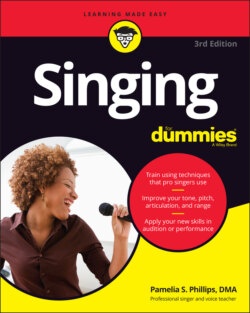Читать книгу Singing For Dummies - Pamelia S. Phillips - Страница 23
Identifying the Fab Four
ОглавлениеThe four voice types are soprano, mezzo, tenor, and bass. Even though these names sound like characters in a mob movie, I promise you that they’re nothing to be afraid of. In the upcoming sections, you discover specific traits about each voice type: the range, register transitions, voice tone, and any subdivisions of that voice type, as well as the names of a few famous singers to help you put a sound with the voice type.
Note that when I talk about register transitions, they don’t occur on just one note. That’s because not all sopranos (or mezzos, tenors, or basses) are the same.
If you’re confused after reading about all the voice types, remember that naming your voice type today isn’t absolutely necessary. After you read the descriptions of the voice types in this chapter, you may be ready to vote soprano over mezzo or bass over tenor for now. Try that range for a while and see whether it fits well. The takeaway from this chapter is to figure out your voice type if you want. If you’re singing most styles of music, your voice type won’t matter as much as figuring out if your voice can sing all the notes in the song you like.
Developing your technique helps you sing more advanced music in any style. Figuring out your voice type can be fun, but it can also take a while to know which category suits you. Remember that your voice will tell you what it can do physically today and then those skills will improve over time and you may end up choosing a different voice type later. It’s much harder to tell if a singer on the radio is a specific voice type. They may have refined their chest voice but not spent time developing their head voice. A singer may sound like a mezzo, but they might be a soprano who just doesn’t perform songs that have higher notes.
Listen to recordings of singers and read about what they’ve sung during their careers. If you know of singers who have voices similar to yours, look at the songs they sang.
What’s the timbre of your voice? Is the tone more steely than chocolaty? Steely isn’t a negative adjective; it’s merely fact. Very often the steely voice is the character audiences love, but they don’t want to rush up and put their arms around them and rescue them.
Is your voice light and flutelike? Is your voice loud and heavy even when you’re lightly singing? Heavy means the sound that you’re making is loud even when you’re singing comfortably. Voices that are a little heavy are full and heavy voices are called dramatic.
What’s your singing range and tessitura? The difference between a mezzo and a soprano often is tessitura. The mezzo can sing the high notes but doesn’t want to live up there, and the soprano wants to sing one high note after another. If you’re new to singing, you may not be able to tell the difference between a soprano and a mezzo or a baritone and a tenor. No worries. Keep listening to the sounds, and you’ll eventually be able to tell the difference between the voice types.
Are you able to move your voice easily? Do you enjoy the fast passages in the song and think of them as fun? If the fast notes are easy for you, you can add coloratura to your vocal description. The coloraturas demonstrate some spectacular fast moves with their voices.
What do you consider the general or overall strengths of your voice — strong middle voice or head voice, perhaps? Your vocal strengths change as you practice. Notice the differences in the voices in the naming names lists that follow. Compare and contrast the sounds you hear between voice types to hear their strengths.
If you’re new to singing, determining your voice type by yourself may take a few months. Your voice changes with practice. So have fun listening and sorting through all the different types.
